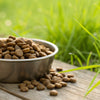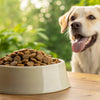Can Dogs Eat Dry Dog Food? Exploring Nutritional Choices for Your Furry Friend
- Houndsy
Table of Contents
- Introduction
- Understanding Dry Dog Food
- Benefits of Feeding Dry Dog Food
- Potential Concerns with Dry Dog Food
- Is Dry Dog Food Enough for Your Dog?
- Choosing the Right Dry Dog Food
- Conclusion
Introduction
Did you know that approximately 60% of dog owners exclusively feed their pets dry dog food? This statistic highlights a common practice among pet parents, but it also raises an essential question: Can dogs eat dry dog food exclusively, and is it healthy for them? As dog lovers, we want to ensure our furry companions receive the best nutrition possible, which is why this topic is not only relevant but crucial for every dog owner.
Over the years, the pet food industry has evolved, with myriad options available, including dry kibble, wet food, fresh food, and even raw diets. However, dry dog food remains popular due to its convenience, shelf-life, and ease of portioning. In this blog post, we will dive deep into the world of dry dog food, exploring its nutritional value, the differences between dry and wet food, and the best practices for feeding our beloved pets.
By the end of this article, you will have a comprehensive understanding of whether your dog can thrive on a diet of dry dog food alone, what to look for in quality kibble, and how to transition effectively if you decide to switch. So, let’s embark on this journey together, reflecting on our feeding routines and ensuring our pets lead happy, healthy lives.
Understanding Dry Dog Food
The Basics of Dry Dog Food
Dry dog food, also known as kibble, is a popular choice among pet owners for several reasons. It is typically made from a mixture of meat, grains, vegetables, and added vitamins and minerals. The manufacturing process involves cooking the ingredients and then forming them into small pellets, which are then dried to create the final product.
The nutritional content of dry dog food is formulated to meet the dietary requirements of dogs, providing them with the necessary proteins, fats, carbohydrates, vitamins, and minerals they need to thrive. Most high-quality dry dog foods are designed to be a complete and balanced diet, meaning they provide all the essential nutrients without the need for additional supplements.
The Nutritional Value of Dry Dog Food
The primary ingredients in dry dog food typically include:
- Protein Sources: Meat, fish, or meat meals are essential for muscle development and overall health. Look for a protein source as the first ingredient on the label.
- Carbohydrates: Ingredients like rice, barley, and oats provide energy and dietary fiber, aiding in digestion.
- Fats: Healthy fats from fish oil or chicken fat are important for skin and coat health.
- Vitamins and Minerals: These are crucial for overall health, supporting immune function, bone health, and energy metabolism.
A good dry dog food formulation will contain between 18-32% protein and 8-22% fat, depending on your dog's specific needs, such as age, activity level, and health considerations.
Benefits of Feeding Dry Dog Food
1. Convenience and Storage
One of the primary advantages of dry dog food is its convenience. Kibble can be stored easily, is mess-free, and can be left out for dogs that prefer to graze throughout the day. This is especially beneficial for busy pet owners who may not have time for multiple feedings.
2. Dental Health
Feeding dry dog food can also contribute to better dental health. The chewing action required to eat kibble helps reduce plaque and tartar buildup, promoting healthier gums. This dental benefit is particularly important as periodontal disease is a common health issue in dogs.
3. Cost-Effectiveness
Dry dog food is often more economical than wet food. It typically comes in larger bags, which can be more affordable in the long run. Additionally, there are fewer spoilage concerns compared to wet food, which can go bad if left out too long.
4. Nutritional Completeness
High-quality dry dog foods are formulated to be nutritionally complete, meaning they provide all the essential nutrients dogs need. Many brands are also tailored for specific life stages or health needs, making it easier to find the right food for your pet.
Potential Concerns with Dry Dog Food
While dry dog food has many benefits, there are also potential downsides to consider.
1. Palatability
Some dogs may find dry food less palatable than wet food. If your dog is a picky eater or has recently transitioned from a wet food diet, they may initially resist dry kibble. In such cases, it might take some time for them to adjust.
2. Hydration
Dry dog food typically contains about 10% moisture, while wet food can have up to 78% moisture. If your dog is eating dry food exclusively, it's crucial to ensure they have access to fresh water at all times to stay hydrated.
3. Weight Management
Dry food can be calorie-dense, which means portion control is essential to prevent obesity. Pet owners should carefully follow feeding guidelines and adjust portions based on their dog's activity level and weight. Obesity is a prevalent health issue in dogs, and managing their diet is key to preventing it.
4. Allergies and Sensitivities
Some dogs may have allergies or sensitivities to certain ingredients commonly found in dry dog food, such as grains or specific protein sources. If you notice any adverse reactions, consult your veterinarian for guidance.
Is Dry Dog Food Enough for Your Dog?
Veterinary Recommendations
Most veterinarians agree that high-quality dry dog food is a suitable option for many dogs. However, they also emphasize the importance of choosing the right food for your dog's specific needs. Some dogs may require a mixed diet of both dry and wet food, while others might thrive on kibble alone.
Transitioning to Dry Dog Food
If you're considering switching your dog to dry food, it's essential to do so gradually. A sudden change in diet can lead to digestive upset. Here’s a recommended transition plan:
- Days 1-3: Mix 25% dry food with 75% of your dog’s current food.
- Days 4-6: Increase to 50% dry food and 50% wet food.
- Days 7-9: Mix 75% dry food with 25% of the previous food.
- Day 10: Feed 100% dry food.
Signs of a Healthy Diet
After transitioning to dry food, monitor your dog for any signs of discomfort or digestive issues. Healthy signs include:
- Consistent energy levels
- Shiny coat
- Healthy weight
- Firm, well-formed stools
Choosing the Right Dry Dog Food
Key Ingredients to Look For
When selecting dry dog food, consider the following:
- High-Quality Protein: Look for named protein sources (e.g., chicken, lamb) as the first ingredient.
- Whole Grains or Alternatives: Grains like brown rice or alternative sources like sweet potatoes provide energy and fiber.
- Healthy Fats: Omega-3 and omega-6 fatty acids support skin and coat health.
- Vitamins and Minerals: Essential for overall health, look for a food that includes a balanced mix of these nutrients.
Brands We Love
At Houndsy, we believe in the importance of feeding our pets high-quality food that aligns with our values of convenience and design excellence. While we don’t produce dog food, we encourage our customers to choose brands that prioritize quality ingredients and nutritional completeness.
Conclusion
In conclusion, yes, dogs can eat dry dog food as their primary source of nutrition, provided it is of high quality and tailored to their individual needs. As responsible pet owners, we should always consult with our veterinarians to determine the best diet for our furry friends. The Houndsy Kibble Dispenser can help simplify your feeding routine by providing perfect portions every time, ensuring your dog enjoys their meals consistently and conveniently.
So, if you’re ready to elevate your dog feeding experience, explore the Houndsy Kibble Dispenser here. With its stylish design and reliable functionality, it’s more than just a feeding tool; it’s a commitment to enhancing your pet’s daily life.
FAQ
Can I mix wet and dry dog food?
Yes, many pet owners find that mixing wet and dry food can provide the best of both worlds, offering variety and ensuring adequate hydration. Just be sure to adjust portion sizes to avoid overfeeding.
How do I know if my dog is eating enough?
Consult your veterinarian to determine your dog’s ideal weight and feeding guidelines. Regular check-ups can help you monitor your dog’s health and adjust their diet as needed.
What should I do if my dog refuses to eat dry food?
If your dog is hesitant to eat dry food, try gradually mixing it with wet food or adding a small amount of broth to enhance the flavor. If they continue to refuse, consult your vet to explore other options.
How can I store dry dog food to keep it fresh?
Store dry dog food in a cool, dry place, ideally in an airtight container to prevent moisture and pests from compromising the food's quality. Always check the expiration date as well.
What is the best way to transition my dog to dry food?
Follow a gradual transition plan, mixing increasing amounts of dry food with their current diet over a period of 7-10 days to minimize digestive upset.












